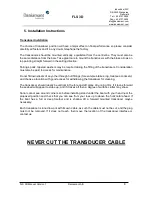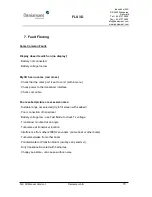
FLS 3D
Industrivej 24C
DK-3550 Slangerup
Denmark
Tel. +45 4737 3800
Fax: +45 4737 3809
www.daniamant.com
FLS 3D Manual Version 1
Daniamant A/S
7
4. Guidance on use
Practice
When learning to interpret the screen practise with clear targets, e.g. a quay wall. Try moving
around an obstruction very gently to see what the maximum range is that different targets become
visible.
!!!!! WARNING !!!!!
If approaching a target, select a range longer than you think you need. Most people (including us!)
seriously underestimate distances to quays, buoys, walls etc.
Note that going astern can push turbulence past the transducer reducing sensitivity or sometimes
obliterating all the picture so take care! Manoeuvre with the minimum use of astern (reverse)
power, especially with the propeller (on twin screw vessels) on the side of the transducer.
Turbulence from other vessels, especially in shallow water can also adversely affect performance.
Algae (normally in spring), Plankton and pollution can all show up as ‘noise’ on the LCD screen.
Operating the FLS 3D at Speed
Ultrasonic signals travel well through solids and liquids but are greatly attenuated in air. It follows
that a stream of turbulence and air bubbles will limit the performance of the FLS system, or any
depth system for that matter. However, if a place can be found on the hull where there is a clear
flow of water, then good results can be obtained even at speed.
























